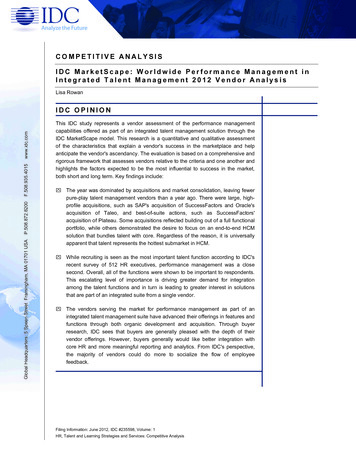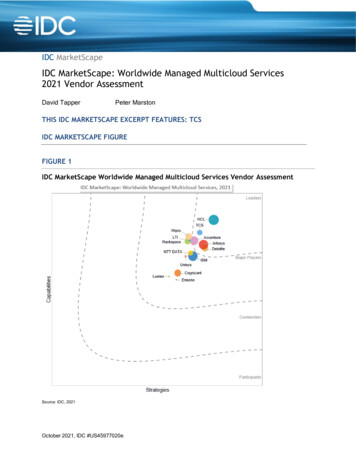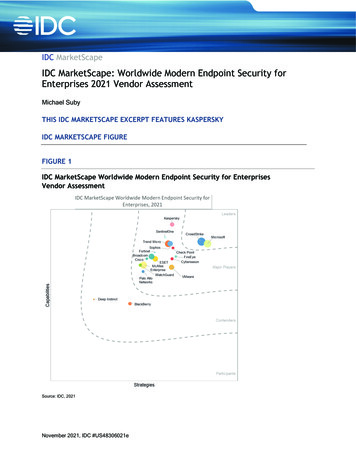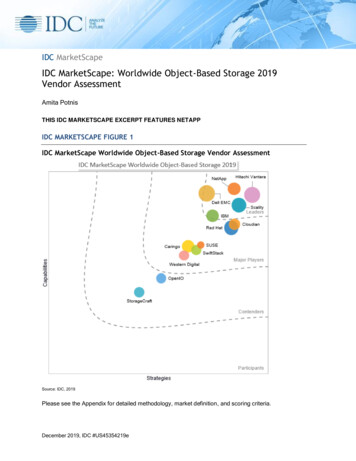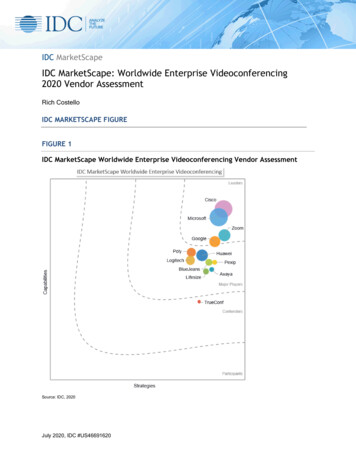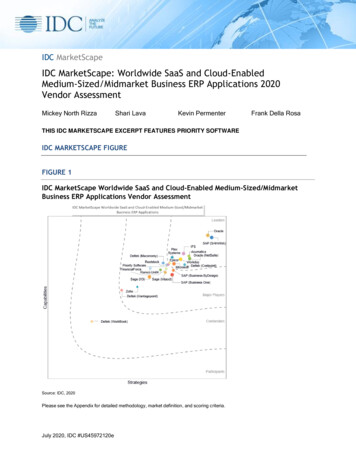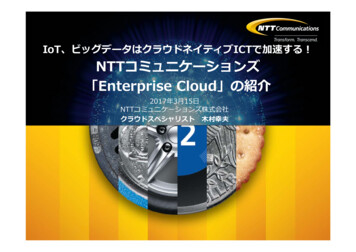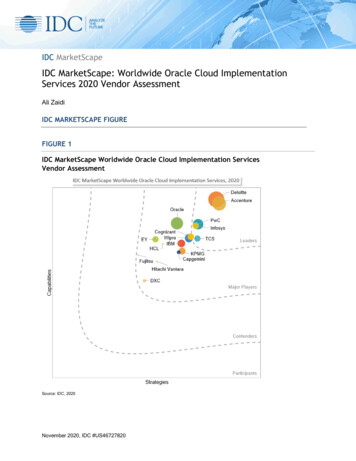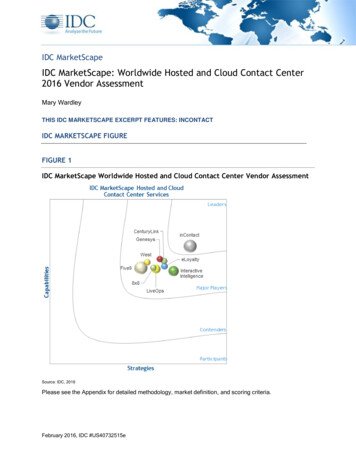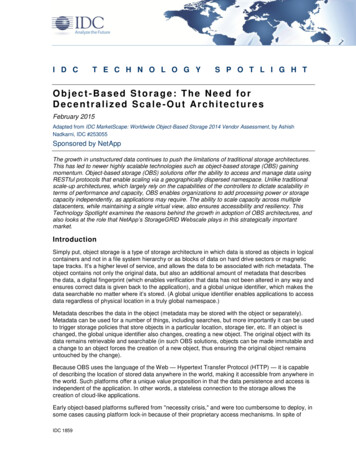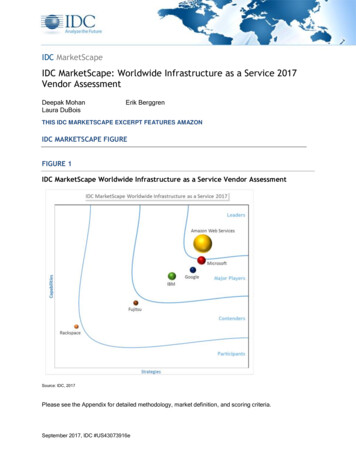
Transcription
IDC MarketScapeIDC MarketScape: Worldwide Infrastructure as a Service 2017Vendor AssessmentDeepak MohanLaura DuBoisErik BerggrenTHIS IDC MARKETSCAPE EXCERPT FEATURES AMAZONIDC MARKETSCAPE FIGUREFIGURE 1IDC MarketScape Worldwide Infrastructure as a Service Vendor AssessmentSource: IDC, 2017Please see the Appendix for detailed methodology, market definition, and scoring criteria.September 2017, IDC #US43073916e
IN THIS EXCERPTThe content for this excerpt was taken directly from IDC MarketScape: Worldwide Infrastructure as aService 2017 Vendor Assessment. Doc #US43073916). All or parts of the following sections areincluded in this excerpt: IDC Opinion, IDC MarketScape Vendor Inclusion Criteria, Essential Guidance,Vendor Summary Profile, Appendix and Learn More. Also included is Figure 1.IDC OPINIONThe growing acceptance and use of infrastructure as a service (IaaS) has transformed how usersprocure and manage compute and storage infrastructure. Over the past decade, we've seen growingacceptance among enterprise companies in running production and analytics workloads in public cloudIaaS supplementing earlier use cases of backup, disaster recovery, and archiving. This is not only fornew applications but also for existing enterprise applications running on-premises, which are beingmigrated to public cloud IaaS. This has given rise to the use of managed services as well as thedevelopment of virtual machine and database migration tools to move workloads into popular publiccloud platforms.Consequentially the use of IaaS is displacing traditional on-premises computing and storageinvestments. Enterprises recognize that IaaS can enable faster time to market for new applications andbring up-front as well as operational cost reductions for existing applications. Among enterprises usingIaaS, the top reasons behind initial adoption have been to reduce infrastructure capital cost and toallocate IT resources to strategic business growth objectives. This interest among enterprises hasfueled a compounded growth of 34.6% in IaaS spending from 2013 to 2016. By way of comparison, theCAGR for spending on physical server and storage infrastructure during the same period was in thesingle digits.The growing acceptance of the use of IaaS by enterprises has increased investments by providers inthis market and increased competition, creating a growth in the number of public cloud IaaS providers.While Amazon Web Services (AWS) dominated the industry for many years, entrants such asMicrosoft, Google, IBM, and regional providers that are expanding (Alibaba, Fujitsu) have given usersmore choice. AWS' early time-to-market advantage has allowed the company to define the market andcontinue to innovate, offering an ongoing stream of new features, functions, and services. However,this pace of innovation, combined with early market advantage and scale of operations, has stymiedsmaller new entrants.The adoption of IaaS continues across the enterprise segment. However, its use is not withoutchallenges. IDC research consistently shows that enterprises using IaaS already are challenged tomeet cost, performance, and security requirements. Alongside that, the options available areincreasing and each cloud provider continues to add differentiated new services on their platform.These fuel consideration across IaaS providers both for new workloads that are planned for the cloudand for redeployment of workloads currently deployed on one public cloud platform. The net usage ofpublic cloud IaaS continues to grow. At the same time, a lot of the public cloud IaaS adoption has beenad hoc, and there is still a relatively low level of maturity across enterprise organizations on how tobest adopt public cloud IaaS solutions — especially when it comes to using multiple public cloudplatforms alongside their existing on-premises infrastructure. The companies that are doing this rightare taking a long-term view with a strategically anchored foundation for the transition and clear longterm objectives and goals regarding needs and expectations from the public cloud platforms. Further, 2017 IDC#US43073916e2
they take a structured comprehensive approach to the transition, catering for skill set buildup, processevolution, and reinforcement of new frameworks. This need is accentuated with the dynamiclandscape of vendor offerings constantly changing the market and opportunities for adopting cloudsolutions.IDC MARKETSCAPE VENDOR INCLUSION CRITERIAIDC tracks in its Public Cloud Services Tracker over 30 global and regional cloud providers with IaaSservices. Many of these service providers are focused on specific regions or have not reached amaterial revenue scale. This MarketScape focuses on global public cloud IaaS providers, which havereached a critical threshold of revenue. The inclusion criteria for service providers included in this IDCMarketScape are as follows: The service provider needed to generate over 100 million in its IaaS business in 2016 The service provider needed to offer IaaS services in multiple, global regions The service provider needed to offer both IaaS compute and storage services in 2016IDC opted to exclude service providers with public cloud service that was in the process of a majortransformation, since the evaluation would not be an accurate reflection of the service.This IDC MarketScape was designed to focus on the top multiregion public cloud services worldwideand is not a comprehensive coverage of public cloud IaaS providers worldwide. Although notdiscussed in this IDC MarketScape — a number of other public cloud IaaS platforms continue to seerapid growth and adoption on a global basis. These include Oracle, which introduced its nextgeneration public cloud IaaS service last year, and Digital Ocean, which has managed to continuegrowth in a hyperscaler-dominated market and has now expanded to IaaS storage services. From aglobal perspective, other notable providers are Alibaba, which is expanding beyond China to otherregions with the Alibaba Cloud; China Telecom in China; and Orange, which is expanding beyondEurope with its public cloud services.ADVICE FOR TECHNOLOGY BUYERSToday, over 70% of CIOs have a cloud-first strategy. This indicates a shift in stance — from publiccloud being a novelty to a mainstream choice. To be successful with a cloud strategy, organizationsmust take a comprehensive approach to adoption. Today, IaaS is a major component of any enterprisecloud adoption strategy. Selecting what workloads to host in a public or private cloud is a majordecision. Further selecting the right vendor for each workload is another complex decision. IDC hasoutlined a framework to help guide organizations to develop their cloud adoption strategy andimplement it. The selection of workloads and vendors for IaaS is part of the second phase (design) ofthis framework. The five major steps are briefly described as follows: Define and align on the high-level goals of the cloud strategy. This is done by answering keyquestions such as: Why should cloud solutions be adopted? What value are we seeking? What business model should be used? Who are our stakeholders?Design the cloud architecture. There are three critical steps in this phase: 2017 IDC#US43073916e3
First, take inventory of existing and expected future IT solutions (using a 24- to 36-monthlens). A necessary and often painful step is to rationalize the portfolio. Second, make decisions for each workload on what should be replaced with a cloudsolution (as well as what should not be) and with what kind of solution. (See Infrastructureand Cloud: A Proactive Approach to Enterprise Cloud Strategies, IDC #256595, June2015.) In this phase, identify the long-term road map and requirements for each workloadand business need. Third, select what vendors should be used for what workload. IDC recommends using thisIDC MarketScape to align providers' strengths with customer needs around eachworkload.Implement the strategy: In this phase, organizations develop an implementation plan, build the skill sets for theexecution, and execute the plan. Along the transition, organizations should measure and track costs and benefits throughthe effort. These will help in the ongoing review of platform performance.Implement ongoing operations, management, and review of the new multicloud environment: The first and by far most critical and difficult issue is around talent management. Newskills and processes are required. Organizations need to answer questions such as: Howdoes moving to the cloud change the organization and its processes? Are moredevelopers needed? What new tools are needed? Will new roles and responsibilities berequired? How should obsolete skills be managed? It's important to clearly define who in the organization is going to monitor and manage theuse of cloud services and resources. To do so is often a full-time job. Further complicatingthis are distributed teams that use IaaS in separate silos versus in a standardized manner.The lack of a concerted effort can miss cost savings opportunities, such as volumediscounting.Govern the cloud transition strategy and framing of the new IT strategy: IDC has developed a framework for how to build a cloud governance structure (see IDCPlanScape: Cloud Strategies — Governance for Your Cloud New World, IDC#US41463615, July 2016). This involves managing the overall demand side for ITsolutions that are driven by the overall organizational strategy, as it evolves with digitaltransformation, and managing the supply of IT between a myriad of cloud providers. It iscritical to get clarity on who's making what decisions in the overall cloud transitionstrategy. For a comprehensive guidance to the different roles needed in the transition, seeCloud Strategies: Needed Roles for the Different Phases of the Cloud Transition, IDC#US41052315, March 2016. Public Cloud IaaS Is Not a Commoditized OfferingOne area that consistently is a concern among enterprises is the best-fit use for IaaS based onexisting application portfolios. Determining which workloads are the best candidates for IaaS is acommon question followed quickly by an economic and operational analysis of the costs associatedwith running workloads in private versus public cloud infrastructure. Following this is the selection ofthe public cloud IaaS provider that best meets customers' needs.Today, IaaS is far from a commoditized offering. While the core set of IaaS offerings is graduallycoming together across top providers, cloud providers still differ in details of number and type of virtual 2017 IDC#US43073916e4
server and storage services they offer. They also vary by the additional services they offer in theirrespective public cloud ecosystems. By way of example, Table 1 provides a high-level comparison ofthe compute services and purchasing options offered by four major IaaS providers.VENDOR SUMMARY PROFILEThis section briefly explains IDC's key observations resulting in a vendor's position in the IDCMarketScape. While every vendor is evaluated against each of the criteria outlined in the Appendix,the description here provides a qualitative summary of the vendor.Amazon Web ServicesAmazon Web Services (AWS) is positioned as a Leader in the IDC MarketScape for worldwideinfrastructure-as-a-service providers.As its position on Figure 1 shows, AWS has effectively defined and led the core offering portfolio in thepublic cloud IaaS market. Its leadership position has come from its first-mover advantage going backto 2006 and its sustained focus on expanding its ecosystem of services to meet customer needs.Across all its services, AWS has over 90 infrastructure services and a broad set of Amazon EC2instance types. Since the beginning of 2016, AWS has accelerated its pace of regional expansion, withnew regions introduced in Canada, the United States (Ohio), the United Kingdom (London), India(Mumbai), and South Korea (Seoul) and additional regions announced for China, France, Hong Kong,Sweden, and the United States. Complementing its regional expansion, AWS has continued functionalexpansion of its core IaaS portfolio and the AWS cloud ecosystem.On the compute side, AWS has launched multiple new services in the past 12 months. These includethe Amazon EC2 Elastic GPUs that allow customers to attach a GPU to an instance just like an EBSvolume, to support use cases such as HPC, application streaming, and gaming. Conversely, on thelower end of the market, Amazon Lightsail bundles T2 instances, SSD storage, data transfer, DNSmanagement, and static IP services for as low as 5/month, targeting Virtual Private Server (VPS) usecases like websites, blogs, and web servers. AWS also continues to refresh its EC2 instancehardware. AWS' X1 instance uses Intel E7 Haswell 4 socket CPUs and AWS' new I/O instancesleverage NVMe SSDs to provide as much as 4 times improvement in IOPS. With Moore's law notoffering the same processor gains as in the past, AWS has leveraged hardware acceleration with F1instance types to build FPGA-embedded instance types that can be programmed for specializedhardware acceleration by customers. The broader AWS compute portfolio includes Amazon'scontainer services (Amazon EC2 Container Service and the Amazon EC2 Container Registry) and theAWS Serverless platform (comprising AWS Lambda and the AWS Step Functions orchestrationservice). These complement the Amazon EC2 instance portfolio, offering customers a rich set of corecompute options for traditional and next-generation application architectures.On the storage side, AWS offers a breadth of storage services, from the original Amazon S3 for objectstorage, to Amazon EBS for block volumes, to the recent Amazon EFS for elastic file storage in thecloud. AWS also offers devices and services to facilitate data and workload migration with Snowball,Snowball Edge, Snowmobile, gateways, and services for database migration. Snowball Edge providescompute and storage services in a 100TB device that sits on-premise. The Snowball Edge leveragesAWS Greengrass, which is a software implementation embedding AWS Lambda functions and otherintegration capabilities with the AWS public cloud. It is unique, in being the first AWS compute offeringthat is designed for customer premises. 2017 IDC#US43073916e5
As noted in Redefining Hybrid Infrastructure: Amazon Brings Cloud Innovations to the Edge (IDC#US42055816, December 2016), the Snowball Edge signals the start of a new direction of growth forAWS IaaS offerings, focusing on computing and storage needs at customer premises. The generalavailability of the VMware Cloud on AWS further strengthens AWS' level of support for hybrid usecases — providing interoperability and integration across public and on-premises platforms across awide range of use cases. AWS also continues to expand the ecosystem of services available tocustomers. These include value-added services available in the AWS cloud — such as the AWSArtificial Intelligence Suite, AWS Batch, and AWS Managed Services, as well as services to enableeasy migration to the cloud — such as the AWS Database Migration Service, AWS Server MigrationService, and AWS Application Discovery Service. The continued innovation on core services and theecosystem underscore the importance that AWS places on the public cloud market and its investmentsto maintain market leadership.StrengthsAWS enjoys a strong market share in the public cloud IaaS market and continues to invest and expandcapabilities for customers in this market (refer back to Figure 1). From an offering perspective, itsstrengths include its breath of datacenters and regions and its ecosystem of services beyond just corecompute and storage. For example, services such as EMR, Athena, Kinesis, RDS, and DynamoDBallow for greater use of AWS data. More recently, Amazon has already increased its focus on enablingenterprise customers to migrate existing workloads to EC2 via tools and services such as AWSworkload migration tools and AWS managed services. The recent VMware Cloud on AWS release isanother major step in this direction, giving AWS a strong value proposition for enterprises building outa hybrid infrastructure strategy for their internal IT.ChallengesA common challenge AWS customers cite is the lack of visibility into increasing AWS costs. This is achallenge that AWS has sought to address with things such as Linked Accounts, consolidated billing,Trusted Advisor, and CloudWatch, although cost visibility or lack of predictable costs is still a challengenoted by enterprise customers. Another common challenge is the spread of options AWS offers,sometimes overwhelming newcomers to the cloud with the array of options.Last, AWS will need to contend with the increased investment and focus by strong challengers such asGoogle and Microsoft. Both companies have been able to benefit from the early lessons and journeythat AWS has gone through in this market, and both are enjoying strong market growth and customeradoption.APPENDIXReading an IDC MarketScape GraphFor the purposes of this analysis, IDC divided potential key measures for success into two primarycategories: capabilities and strategies.Positioning on the y-axis reflects the vendor's current capabilities and menu of services and how wellaligned the vendor is to customer needs. The capabilities category focuses on the capabilities of thecompany and product today, here and now. Under this category, IDC analysts will look at how well avendor is building/delivering capabilities that enable it to execute its chosen strategy in the market. 2017 IDC#US43073916e6
Positioning on the x-axis, or strategies axis, indicates how well the vendor's future strategy aligns withwhat customers will require in three to five years. The strategies category focuses on high-leveldecisions and underlying assumptions about offerings, customer segments, and business and go-tomarket plans for the next three to five years.The size of the individual vendor markers in the IDC MarketScape represents the market share of eachindividual vendor within the specific market segment being assessed. In the case of the IDCMarketScape for IaaS, these have been tweaked for them to be easy to visualize — primarily becauseof the order of magnitude lead that the leader holds in this market.IDC MarketScape MethodologyIDC MarketScape criteria selection, weightings, and vendor scores represent well-researched IDCjudgment about the market and specific vendors. IDC analysts tailor the range of standardcharacteristics by which vendors are measured through structured discussions, surveys, andinterviews with market leaders, participants, and end users. Market weightings are based on userinterviews, buyer surveys, and the input of IDC experts in each market. IDC analysts' base individualvendor scores, and ultimately vendor positions on the IDC MarketScape, on detailed surveys andinterviews with the vendors, publicly available information, and end-user experiences in an effort toprovide an accurate and consistent assessment of each vendor's characteristics, behavior, andcapability.Market DefinitionIDC defines cloud services through a checklist of key attributes that an offering must manifest to endusers of the service. To qualify as a "cloud service," as defined by IDC, an offering must support all ofthe six attributes.Cloud services may be deployed through a variety of deployment models. At the highest level, thereare two types of deployment models for cloud services — public and private: Public cloud services are shared among unrelated enterprises and/or consumers, are open toa largely unrestricted universe of potential users, and are designed for a market, not a singleenterprise. Private cloud services are shared within a single enterprise or extended enterprise, withrestrictions on access and level of resource dedication, defined/controlled by the enterpriseand beyond the control available in public cloud offerings.In the public cloud world, we define one major model — the public cloud service. Underneath this bigumbrella, there is a growing variety of options available, relating to public/private/VPN networkconnection, geolocation of data, options for dedicated data storage devices, and so forth. IDCconsiders these all "subspecies" within the public cloud world.The public cloud IaaS market forecast also includes on-demand hosted private cloud (HPC). In thisdeployment model, SPs dynamically provision resources for dedicated use from a shared pool — oftenfrom the same pool as their public cloud offerings. Through cloud automation, SPs offer a procurementexperience that is essentially the same as their public cloud offerings, with rapid self-serviceprovisioning, ability to quickly scale resources up/down, flexible pricing, APIs, rapid enhancementcycles, and very short-term commitments (as short as minutes or hours). Examples include AmazonWeb Services' Dedicated Instances and IBM-SoftLayer Bare Metal Servers. Because on-demand HPCservices are emerging as an optional offering from public cloud services providers — delivered from the 2017 IDC#US43073916e7
same provisioning environment, using the same resources, and offering similar economics as fullyshared public cloud services — we include on-demand hosted private cloud services in this study.The IaaS primary market is further segmented into the following secondary markets — basic storage,servers, and network. With this approach, the functional definition (with inclusions/exclusions) of eachcloud services segment is essentially the same as the functional definition found in IDC's traditional ITproducts taxonomies but delivered as cloud services.Basic storage and servers include all server capacity and raw storage capacity, respectively, deliveredas cloud services. Storage-related cloud services that are above and beyond raw storage — includingbackup, archiving, continuity, and data synchronization — are classified as advanced storage andcategorized under system infrastructure software cloud services (a submarket of SaaS).For more details about our cloud services taxonomy, check out IDC's Worldwide IT Cloud ServicesTaxonomy, 2015 (IDC #258348, September 2015). 2017 IDC#US43073916e8
LEARN MORERelated Research Multicloud Infrastructure as a Service as a Public Cloud Adoption Pattern (IDC #WC20160825,August 2016) IDC PlanScape: Cloud Strategies - Governance for Your Cloud New World (IDC#US41463615, July 2016) Worldwide Public Cloud Infrastructure as a Service Forecast, 2016-2020 (IDC #US41556916,June 2016) IDC PlanScape: Building the Business Case for the Cloud Transition Strategy (IDC#US41154516, April 2016) Cloud Strategies: Needed Roles for the Different Phases of the Cloud Transition (IDC#US41052315, March 2016) Infrastructure and Cloud: A Proactive Approach to Enterprise Cloud Strategies (IDC #256595,June 2015)SynopsisThis IDC study represents a vendor assessment of infrastructure as a service through the IDCMarketScape model. The ramp up of public cloud adoption by enterprises, accompanied by steadyinvestment in expansion of cloud services by the market leaders, has broadened the range of publiccloud ecosystems for the end customer. The shift in focus from prices to ecosystem is beneficial toboth providers and customers, with public cloud providers investing in differentiated ecosystems andvalue-added services, and end customers selecting a mix of public cloud providers for their workloads."While core IaaS services are starting to look similar across the market leaders, this is still a fastevolving market with continued innovations being introduced in both compute and storage portfolios. Inaddition, differentiation in the ecosystem of tools and higher-layer services will continue to be a strongway in which public cloud providers differentiate and position themselves in this market." said DeepakMohan, research director, Public Cloud Infrastructure as a Service. "As enterprises look at thespectrum of options available, careful consideration of internal IT strategy, and detailed evaluation ofprovider portfolios, will maximize the benefits delivered to the enterprise through cloud adoption.""With more and more choices stemming from increased competition between the major players in thecloud space, there are many good opportunities to capitalize from it. The winner here is clearly thecustomer. Organizations have the opportunity to leverage cloud solutions to increase theircompetitiveness both operationally and strategically. Leveraging IaaS solutions has its place in anycloud transition strategy. Companies should take a structured comprehensive approach whendeveloping their cloud transition strategy," states Erik Berggren, VP, Cloud Strategies at IDC. 2017 IDC#US43073916e9
About IDCInternational Data Corporation (IDC) is the premier global provider of market intelligence, advisoryservices, and events for the information technology, telecommunications and consumer technologymarkets. IDC helps IT professionals, business executives, and the investment community make factbased decisions on technology purchases and business strategy. More than 1,100 IDC analystsprovide global, regional, and local expertise on technology and industry opportunities and trends inover 110 countries worldwide. For 50 years, IDC has provided strategic insights to help our clientsachieve their key business objectives. IDC is a subsidiary of IDG, the world's leading technologymedia, research, and events company.Global Headquarters5 Speen StreetFramingham, MA 01701USA508.872.8200Twitter: @IDCidc-community.comwww.idc.comCopyright and Trademark NoticeThis IDC research document was published as part of an IDC continuous intelligence service, providing writtenresearch, analyst interactions, telebriefings, and conferences. Visit www.idc.com to learn more about IDCsubscription and consulting services. To view a list of IDC offices worldwide, visit www.idc.com/offices. Pleasecontact the IDC Hotline at 800.343.4952, ext. 7988 (or 1.508.988.7988) or sales@idc.com for information onapplying the price of this document toward the purchase of an IDC service or for information on additional copiesor web rights. IDC and IDC MarketScape are trademarks of International Data Group, Inc.Copyright 2017 IDC. Reproduction is forbidden unless authorized. All rights reserved.
IDC tracks in its Public Cloud Services Tracker over 30 global and regional cloud providers with IaaS services. Many of these service providers are focused on specific regions or have not reached a material revenue scale. This MarketScape focuses on global public cloud IaaS providers, which have reached a critical threshold of revenue.
